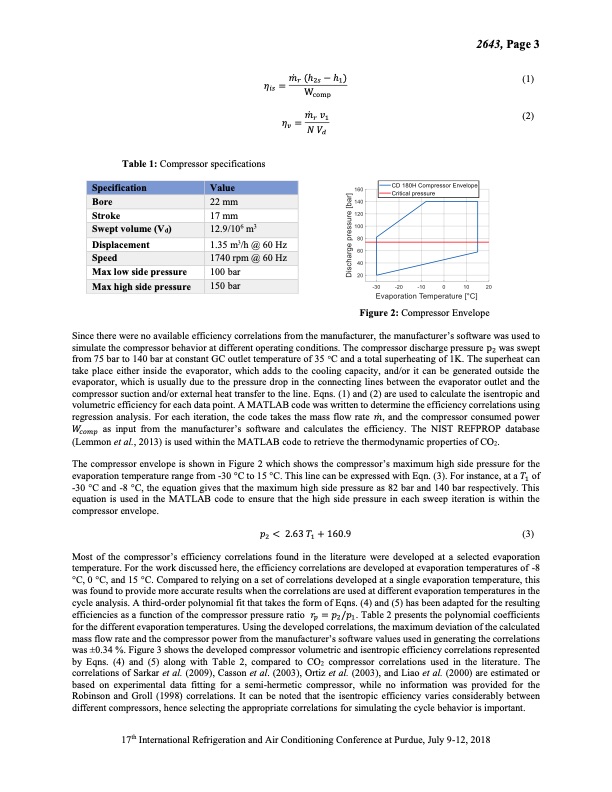
PDF Publication Title:
Text from PDF Page: 004
Table 1: Compressor specifications Specification Bore Stroke Swept volume (Vd) Displacement Speed Max low side pressure Max high side pressure Value 22 mm 17 mm 12.9/106 m3 1.35 m3/h @ 60 Hz 1740rpm@60Hz 100 bar 150 bar 𝜂 𝑖 𝑠 = 𝑚̇ 𝑟 ( h 2 𝑠 − h 1 ) Wcomp 2643, Page 3 ( 1 ) (2) 𝜂𝑣 = 𝑚̇ 𝑟 𝑣1 𝑁𝑉 𝑑 Figure 2: Compressor Envelope Since there were no available efficiency correlations from the manufacturer, the manufacturer’s software was used to simulate the compressor behavior at different operating conditions. The compressor discharge pressure p2 was swept from 75 bar to 140 bar at constant GC outlet temperature of 35 °C and a total superheating of 1K. The superheat can take place either inside the evaporator, which adds to the cooling capacity, and/or it can be generated outside the evaporator, which is usually due to the pressure drop in the connecting lines between the evaporator outlet and the compressor suction and/or external heat transfer to the line. Eqns. (1) and (2) are used to calculate the isentropic and volumetric efficiency for each data point. A MATLAB code was written to determine the efficiency correlations using regression analysis. For each iteration, the code takes the mass flow rate 𝑚̇ , and the compressor consumed power 𝑊 as input from the manufacturer’s software and calculates the efficiency. The NIST REFPROP database 𝑐𝑜𝑚𝑝 (Lemmon et al., 2013) is used within the MATLAB code to retrieve the thermodynamic properties of CO2. The compressor envelope is shown in Figure 2 which shows the compressor’s maximum high side pressure for the evaporation temperature range from -30 °C to 15 °C. This line can be expressed with Eqn. (3). For instance, at a 𝑇 of 1 -30 °C and -8 °C, the equation gives that the maximum high side pressure as 82 bar and 140 bar respectively. This equation is used in the MATLAB code to ensure that the high side pressure in each sweep iteration is within the compressor envelope. 𝑝 < 2.63𝑇 +160.9 (3) 21 Most of the compressor’s efficiency correlations found in the literature were developed at a selected evaporation temperature. For the work discussed here, the efficiency correlations are developed at evaporation temperatures of -8 °C, 0 °C, and 15 °C. Compared to relying on a set of correlations developed at a single evaporation temperature, this was found to provide more accurate results when the correlations are used at different evaporation temperatures in the cycle analysis. A third-order polynomial fit that takes the form of Eqns. (4) and (5) has been adapted for the resulting efficiencies as a function of the compressor pressure ratio 𝑟 = 𝑝 /𝑝 . Table 2 presents the polynomial coefficients 𝑝21 for the different evaporation temperatures. Using the developed correlations, the maximum deviation of the calculated mass flow rate and the compressor power from the manufacturer’s software values used in generating the correlations was ±0.34 %. Figure 3 shows the developed compressor volumetric and isentropic efficiency correlations represented by Eqns. (4) and (5) along with Table 2, compared to CO2 compressor correlations used in the literature. The correlations of Sarkar et al. (2009), Casson et al. (2003), Ortiz et al. (2003), and Liao et al. (2000) are estimated or based on experimental data fitting for a semi-hermetic compressor, while no information was provided for the Robinson and Groll (1998) correlations. It can be noted that the isentropic efficiency varies considerably between different compressors, hence selecting the appropriate correlations for simulating the cycle behavior is important. 17th International Refrigeration and Air Conditioning Conference at Purdue, July 9-12, 2018PDF Image | Transcritical CO2 Heat Pump Cycle

PDF Search Title:
Transcritical CO2 Heat Pump CycleOriginal File Name Searched:
220147355.pdfDIY PDF Search: Google It | Yahoo | Bing
CO2 Organic Rankine Cycle Experimenter Platform The supercritical CO2 phase change system is both a heat pump and organic rankine cycle which can be used for those purposes and as a supercritical extractor for advanced subcritical and supercritical extraction technology. Uses include producing nanoparticles, precious metal CO2 extraction, lithium battery recycling, and other applications... More Info
Heat Pumps CO2 ORC Heat Pump System Platform More Info
| CONTACT TEL: 608-238-6001 Email: greg@infinityturbine.com | RSS | AMP |